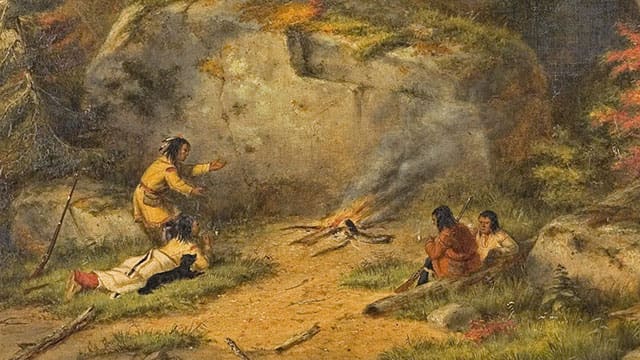Claims of Aboriginal moral superiority over European savagery have no basis in Canadian history

Genocide. Ethnic cleansing. Forced assimilation. Slavery. Racism.
Mainstream history and traditional anthropology have demonstrated that these five phenomena are nearly universal aspects of the human condition. However, in contemporary academic, governmental, and media circles, these issues are often depicted as inventions that late 15th-century European colonizers used to subjugate, exploit, or exterminate Indigenous peoples around the world.
In Canada, this skewed portrait of the five sins of Westernization portrays the pre-contact New World as a veritable Garden of Eden inhabited by a myriad of aboriginal groups, mostly living peacefully with each other and in harmony with nature. The Indigenous “fall from grace,” if any, was precipitated entirely by the arrival of Europeans.
The de facto Book of Genesis for Canada’s Indigenous creation story is the 4,000-page 1996 Report of the Royal Commission on Aboriginal Peoples (RRCAP).
Among its many evidentiary shortcomings, it privileges unverifiable oral history over well-documented written accounts; makes no mention of periodic pre-contact hunger, starvation, or famine; only fleetingly refers to “violent death and cannibalism” and occasional warfare among the militaristic Iroquois; briefly comments on lethal conflict among the famously warlike Blackfoot; and buries pervasive West coast pre-contact slavery in a one-sentence footnote.
Conversely, the Report extensively addresses similar activities, some now considered crimes against humanity, when committed by European societies, regardless of their relevance to Canada. This selective and partial narrative has become our country’s “official history.” It is increasingly taught in schools and constantly echoed by prominent members of the Canadian intelligentsia. One of the latest to do so is Niigaan Sinclair, Associate Professor of native studies at the University of Manitoba and son of Senator Murray Sinclair, former chair of the Indian Residential Schools Truth and Reconciliation Commission.
There is no evidence that the aboriginal settlers of the Americas were any different from their pre-modern counterparts around the world, including those in Western Europe, in how they coped with severe survival challenges. As equal members of the human race, their political evolution was unique to each group, but humanity’s overall path, known as general evolution, followed a similar trajectory. Starting around 100,000 years ago with loosely structured, scattered, highly mobile multi-family groups, and leading to the first state societies about 5,000 years ago, this process often involved a combination of slaughter, subjugation, tribute extortion, assimilation, and expulsion of foes.
Across the globe, infanticide was used to control population growth beyond the environmental carrying capacity of stone-age hunters and gatherers. Ethnic cleansing occurred when local groups exceeded the demographic sustainability of their territories, targeting neighbouring groups. Cannibalism was practiced in response to hunger or to capture the spiritual power of competitors. Genocide, or the wholesale extermination of enemies, was organized to seize territory or eliminate military threats. Almost any alien group could be subjected to enslavement in support of forced labour, sexual exploitation, trade, or status enhancement.
Around the world, groups that excelled at these practices, including the Aztecs of Mexico and the Incas of Peru, gradually evolved into state-level societies. In the process, they typically conquered, exiled, or absorbed their neighbours. Sometimes they even butchered them for food, as the Aztecs did to obtain enough protein in the fauna-scarce Valley of Mexico.
As for Canada, the historical record consistently and comprehensively reports that Canada’s Indigenous inhabitants mutilated, tortured to death, and cannibalized enemies; enslaved members of neighbouring groups; massacred competitors for land and resources; and exterminated entire ethnic groups.
In short, the preponderance of scientific evidence, as opposed to tales told around eons of campfires, indicates Canada’s first inhabitants acted just as beastly as the rest of the human family.
The post-contact European treatment of Canada’s original inhabitants did not involve genocide, slavery, ethnic cleansing, total assimilation, or tribute extraction. Instead, European settlement, beginning in 1535, led to permanent pacification, a vibrant exchange of Indigenous products for European manufactured goods over 250 years, and the investment of tens of billions of dollars since Confederation in 1867 to enhance the well-being of Indigenous peoples.
Warts and all, no country has ever done more for its Indigenous people.
Haughty claims of Aboriginal moral superiority over European savagery have no foundation in Canadian history.
Hymie Rubenstein, editor of REAL Indigenous Report, is a retired professor of anthropology and was a board member of and taught for many years at St. Paul’s College, University of Manitoba, the only Roman Catholic higher education institution in Manitoba. He and Rodney Clifton from the Frontier Centre for Public Policy are authors of Residential School Recrimination, Repentance, and Reality.
For interview requests, click here.
The opinions expressed by our columnists and contributors are theirs alone and do not inherently or expressly reflect the views of our publication.
© Troy Media
Troy Media is an editorial content provider to media outlets and its own hosted community news outlets across Canada.


